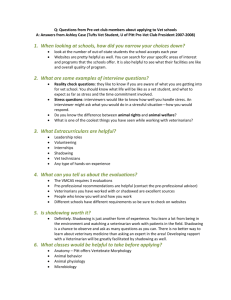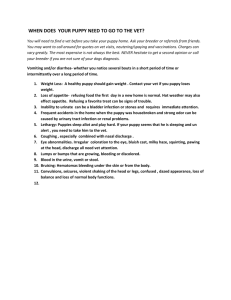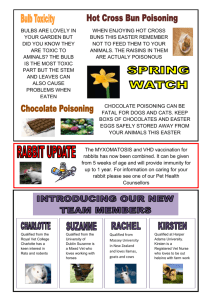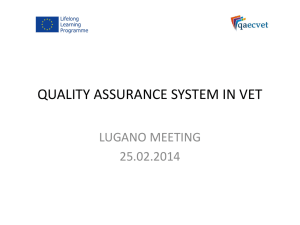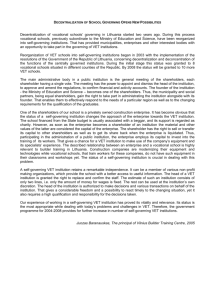Guidelines for conducting Joint Workshops
advertisement
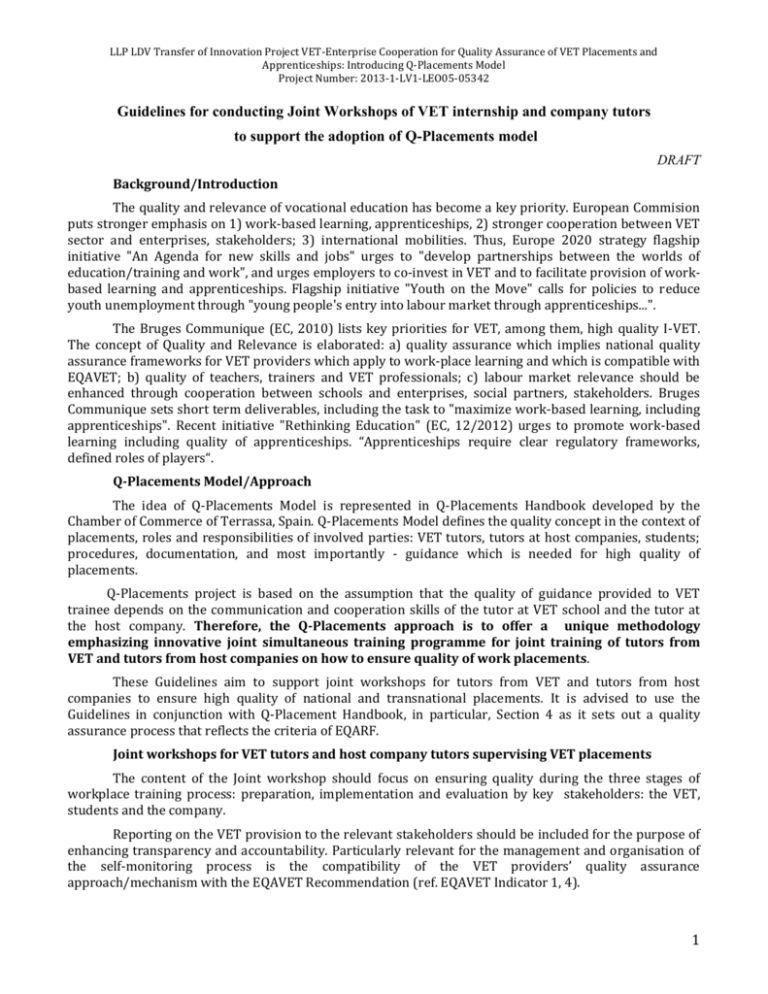
LLP LDV Transfer of Innovation Project VET-Enterprise Cooperation for Quality Assurance of VET Placements and Apprenticeships: Introducing Q-Placements Model Project Number: 2013-1-LV1-LEO05-05342 Guidelines for conducting Joint Workshops of VET internship and company tutors to support the adoption of Q-Placements model DRAFT Background/Introduction The quality and relevance of vocational education has become a key priority. European Commision puts stronger emphasis on 1) work-based learning, apprenticeships, 2) stronger cooperation between VET sector and enterprises, stakeholders; 3) international mobilities. Thus, Europe 2020 strategy flagship initiative "An Agenda for new skills and jobs" urges to "develop partnerships between the worlds of education/training and work", and urges employers to co-invest in VET and to facilitate provision of workbased learning and apprenticeships. Flagship initiative "Youth on the Move" calls for policies to reduce youth unemployment through "young people's entry into labour market through apprenticeships...". The Bruges Communique (EC, 2010) lists key priorities for VET, among them, high quality I-VET. The concept of Quality and Relevance is elaborated: a) quality assurance which implies national quality assurance frameworks for VET providers which apply to work-place learning and which is compatible with EQAVET; b) quality of teachers, trainers and VET professionals; c) labour market relevance should be enhanced through cooperation between schools and enterprises, social partners, stakeholders. Bruges Communique sets short term deliverables, including the task to "maximize work-based learning, including apprenticeships". Recent initiative "Rethinking Education" (EC, 12/2012) urges to promote work-based learning including quality of apprenticeships. “Apprenticeships require clear regulatory frameworks, defined roles of players“. Q-Placements Model/Approach The idea of Q-Placements Model is represented in Q-Placements Handbook developed by the Chamber of Commerce of Terrassa, Spain. Q-Placements Model defines the quality concept in the context of placements, roles and responsibilities of involved parties: VET tutors, tutors at host companies, students; procedures, documentation, and most importantly - guidance which is needed for high quality of placements. Q-Placements project is based on the assumption that the quality of guidance provided to VET trainee depends on the communication and cooperation skills of the tutor at VET school and the tutor at the host company. Therefore, the Q-Placements approach is to offer a unique methodology emphasizing innovative joint simultaneous training programme for joint training of tutors from VET and tutors from host companies on how to ensure quality of work placements. These Guidelines aim to support joint workshops for tutors from VET and tutors from host companies to ensure high quality of national and transnational placements. It is advised to use the Guidelines in conjunction with Q-Placement Handbook, in particular, Section 4 as it sets out a quality assurance process that reflects the criteria of EQARF. Joint workshops for VET tutors and host company tutors supervising VET placements The content of the Joint workshop should focus on ensuring quality during the three stages of workplace training process: preparation, implementation and evaluation by key stakeholders: the VET, students and the company. Reporting on the VET provision to the relevant stakeholders should be included for the purpose of enhancing transparency and accountability. Particularly relevant for the management and organisation of the self-monitoring process is the compatibility of the VET providers’ quality assurance approach/mechanism with the EQAVET Recommendation (ref. EQAVET Indicator 1, 4). 1 LLP LDV Transfer of Innovation Project VET-Enterprise Cooperation for Quality Assurance of VET Placements and Apprenticeships: Introducing Q-Placements Model Project Number: 2013-1-LV1-LEO05-05342 The issues discussed during training would vary based on different workplace training systems and players. The sample of issues for each stage of workplace training provided below is indicative and have to be adapted to the particular national context. To provide better advice on methodological support for VET staff and host companies' supervisors and/or mentors of placements for adoption of Q-placements it is useful to use a case study methodology. Mini cases from real life experience of the workshop participants would allow to discuss common problems in a typical situation and promote group discussion and group problem-solving (ref. EQAVET Indicator 2, 3, 4, 5). Tips for Joint Workshops of VET internship and company tutors Following tips are designed to help to think through these important aspects of a Joint workshops of VET internship and company tutors to support the adoption Q-Placements model: 1. Clarify the requirement area and scope for the workshop. What are you trying to accomplish by bringing the participants together into the workshop? How will you know the workshop has been successful? The motivation to participate can be achieved by designing clear and understandable objectives and outcomes of the workshop and communicating the benefits participants will receive during training. 2. Identify which stakeholders need to participate in the workshop. The target audience of the national workshops include work placement tutors from VET and host companies; representatives from intermediate organizations involved in delivering internships. Determine whether or not it is feasible to gather this group together all at one time for the workshop. When selecting participants it is advisable to keep age and gender balance to be able to reflect different opinions during the workshop. 3. The promotion channels for the workshop may vary among different countries, e.g., the VET representatives could be reached directly by sending invitation to participate in the seminar. The company tutors could be reached via VET representatives or via respective bodies who are in charge in particular countries for delivering work placements, etc. Another effective communication tool could be company visits to introduce the workshop. 4. Set the stage and expectations. Consider VET stakeholders’ needs (ref. EQAVET Indicator 9). Use the Workshop planning template (Annex 1) to help you organize and complete the workshop planning and preparation activities. Draft and distribute the agenda and any pre-workshop preparation material at least a week ahead of the meeting, allowing ample time for review. 5. Focus on critical issues. All three stages are crucial in delivering Q- Placement. Preparation stage issues: From VET side it includes such topics like: Making sure that necessary policies, procedures, documents are in place Selecting students for particular companies Understanding students and company expectations form internship; Explaining the expected learning outcomes by delivering a work program (plan) to students and company representatives; Developing and delivering key terminology list to company representatives wherever is appropriate; Preparing students for internship (good code of conduct, necessity to communicate problems if any with company tutor and VET tutor); Explaining to students the requirements of internship report; Signing agreement from VET side on internship with students and company; 2 LLP LDV Transfer of Innovation Project VET-Enterprise Cooperation for Quality Assurance of VET Placements and Apprenticeships: Introducing Q-Placements Model Project Number: 2013-1-LV1-LEO05-05342 In case is necessary meeting family of student/s ; From company side: Making sure that necessary policies, procedures, documents related to preparation stage are in place Understanding the internship program and expected outcomes of internship via effective communication with VET representatives; Preparing working place; Appointing company tutor for particular student/s; Informing company staff about incoming students; Preparing welcome package to students; Preparing welcome session to students; Signing internship contract/s with students and VET; Methodology of training for preparation stage: case study group work group reflection group presentation role play trainer presentation (if necessary) Implementation stage issues: From VET side: making sure that necessary policies, procedures, documents related to implementation stage are in place; monitoring progress of internship by providing regular visits to company; ensuring communication with student and company tutor on regular basis From company side: making sure that necessary policies, procedures, documents related to implementation stage are in place; conducting welcome and introduction session in workplace; ensuring that assigned tasks are provided to student; communicating with VET tutor about problems if any occur delivering feedback to students on progress achieved and fulfillment of program Methodology of training for implementation stage: case study group work group reflection group presentation role play trainer presentation (if necessary) Evaluation stage issues: 3 LLP LDV Transfer of Innovation Project VET-Enterprise Cooperation for Quality Assurance of VET Placements and Apprenticeships: Introducing Q-Placements Model Project Number: 2013-1-LV1-LEO05-05342 From VET side: making sure that necessary policies, procedures, documents related to evaluation stage are in place; receiving and evaluating report on internship organizing defense of internship report ( wherever is appropriate) gathering feedback from student on particular experience in given company analyzing results of internship in order to improve quality; From company side: making sure that necessary policies, procedures, documents related to evaluation stage are in place; providing feedback to student on progress during internship signing students report ( wherever is appropriate) communicating results/ experience with VET representatives/ tutors, providing feedback; Methodology of training for implementation stage: 6. case study group work group reflection group presentation role play trainer presentation (if necessary) Well planned workshops include: clear and deliberate opening and closing activities; carefully selected exercises, discussions, and activities to elicit and model the requirements; facilitation with the right balance of flexibility and diligence. Use the Practical Tips for Conducting joint workshops of VET internship and company tutors (Annex 2) 7. Conduct the workshop. Remember to thank your participants for sharing their time and knowledge, both as you begin and at the conclusion of the workshop. Reiterate any key findings or points captured during the meeting, and distribute a summary to all participants as a means to seek clarity and feedback on the requirements details you captured. 4


